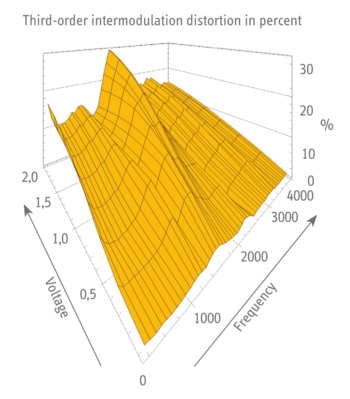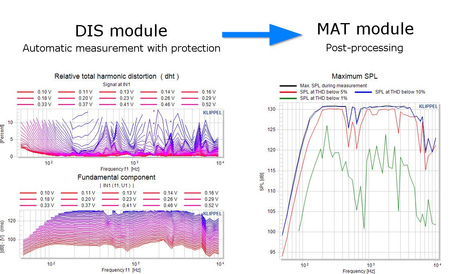3D-Distortion Measurement (DIS)
Features and Benefits
- Optimal for measurements of transducers and audio systems
- Considers mechanical, electrical, acoustical signals
- Measures voice coil temperature
- Visualizes amplitude compression
- Detects critical speaker distortion
- Assesses maximal output
- Thermal and mechanical protection
- Adjusts voltage at speaker terminals
- Detects amplifier gain automatically
This module performs a series of steady-state measurements by using a single- or two-tone excitation signal varied in frequency and voltage. Two signals may be measured simultaneously (e.g. current, voltage, displacement, SPL). Due to high quality converters and synchronous data acquisition, the spectral components (fundamental, harmonic and intermodulation distortions, DC part) can be obtained with high signal to noise ratio up to 48 kHz signal frequency. After performing the measurement (voltage and frequency sweep), the magnitude of the spectral components is displayed in a 3D or 2D plot versus voltage and frequency of the excitation tone.
The 3D-Distortion Measurement (DIS) provides features especially valuable for transducer measurements. The transducer can be protected against mechanical and thermal overload by pausing the measurement automatically if the total harmonic distortion or the increase of the voice coil temperature violates user defined limits.
Specification
Corresponds with the following standard measurements
Intermodulation distortion
Harmonic distortion
DC displacement – dynamic offset the voice coil
Compression of fundamental components
Separated loudspeaker distortion
Voltage and current
Voice coil temperature
Waveform and spectrum
Magnitude and phase response
Far field sound pressure on-axis
Radiation analysis
Near field measurement
Products
DIS Standard
provides all standard measurements according to IEC 60268-5.
DIS PRO
provides amplitude modulation distortion in addition to the functionality of the DIS Standard.
Requirements
Hardware
• KLIPPEL Analyzer 3 (KA3)
Accessories
• Power amplifier
• Laser sensor (optional)
• PC
The figure illustrates the measurement of the maximal SPL level at a defined THD limit (1, 5 and 10 percent) using DIS measurement and MAT 2.0 post-processing module. The DIS module varies the amplitude of the stimulus and protects the transducer under test against mechanical and thermal overload. The MAT 2.0 module extracts the measurement results of the DIS automatically and calculates the corresponding SPL limits. There is an object template available for this application in dB-Lab called “Max SPL Level for given THD.
Templates coming with the DIS module:
DIS 3D Harmonics AN 9 | Harmonic distortions versus frequency and voltage according Application Note AN 9 |
DIS 3D Intermodulation AN8 | Intermodulation distortions versus frequency and voltage according Application Note AN 8 |
DIS Compliance Asymmetry AN 15 | Checking for asymmetries caused by compliance according Application Note AN 15 |
DIS Compression Out(in) | Output amplitude versus input amplitude at four frequencies |
DIS Harmonics vs. Voltage | Harmonic distortion measurement versus amplitude |
DIS HI-2 | Weighted harmonic distortion (blat distortion) used for Application Note AN 7 |
DIS IM Dist. (bass sweep) | Intermodulation distortion in current and sound pressure using a variable bass tone fs/4 < f1 < 4fs and a fixed voice tone f2 >> fs |
DIS IM Dist. (voice sweep) | Intermodulation distortion in current and sound pressure by using a fixed bass tone f2 < fs and a variable voice tone f1>> fs |
DIS Motor stability | Checking motor stability at frequency 1.5 fs (where Xdc is maximal) according Application Note AN 14 |
DIS SPL, Harm protected | Harmonic distortion measurement with protection |
DIS X Fundamental, DC | Fundamental and DC component of displacement |
DIS Separation AM Distortion | Amplitude modulation distortion according Application Note AN 10 |
Related Information
Other Modules of the R&D and QC System
Application Notes
AN 4 Peak Displacement Xmax
AN 6 Amplitude Modulation
AN 72 Testing wireless audio devices with Klippel R&D
Standards
Consumer Electronics Association
CEA-CEB19, CEA-803 R200X, CEA-2006-A, CEA-2019, CEA-2031
International Electrotechnical Commission
IEC 60268-1, IEC 60268-3, IEC 60268-4, IEC 60268-5, IEC 60268-7, IEC 60268-21, IEC 60268-22, IEC 61094-5, IEC 61305-5, IEC 61842, IEC WD 63034
European Standards
BS EN 54-24, BS EN 50332
Audio Engineering Society
AES2, AES56
Institute of Electrical and Electronics Engineers
IEEE 269, IEEE 1206, IEEE 1329, IEEE 1652
American National Standards Institute
ANSI S1.15-Part 1, ANSI S1.15-Part 2, ANSI S3.7, ANSI S3.22, ANSI S3.25, ANSI S12.42
International Telecommunication Union
ITU-R Recommendation BS. 775-2, ITU-R Recommendation BS. 1116, ITU-R Recommendation BS. 1534-1, ITU-T Recommendation P.79
Telecommunications Industry Association
TIA-470, TIA-810, TIA-920
American Society for Testing and Materials
ASTM F2504-05


